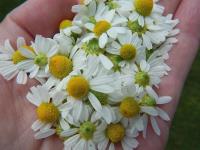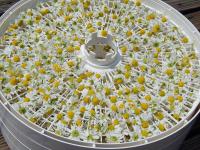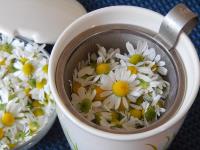ALL about Chamomile
Ahhhh, Chamomile! This lovely plant adds cute little daisy-like flowers to your herbal tea garden ... and a soothing, apple-y flavor to your cup!
Chamomile Basics
|
Varieties Used for Tea: German (annual), Roman (perennial) Hardy To: -20°F / -29°C |
Start From: Seeds, nursery plants Space Required: 12 in. / 30 cm. Grow in Containers: Yes Parts Used for Tea: Flowers |
Chamomile Varieties
The most common varieties of the chamomile herb are:
- German (matricaria recutita), and
- Roman (chamaemelum nobile)
Both varieties make delicious tea, either alone or combined with other herbs to create your favorite custom blends.
German Chamomile
Easy to grow from seed, this no-fuss plant is perfect for first-time herbal tea gardeners.
 All This Chamomile From One Packet of Seeds!
All This Chamomile From One Packet of Seeds!Characteristics: Annual. Long, "leggy", multi-branched stems with sparse, feathery foliage, topped by a daisy-like flower.
Cultivation: Seed or starter plant. Sow seeds in early spring for same-year bloom. Sow in late autumn for next-year flowering. After this herb is established in the garden, it's a prolific self-seeder.
Growing Conditions: Average soil, full sun. Can tolerate a little drought, but blooms best when the soil is kept evenly moist (not water-logged!).
Bloom Time: Early summer to first frost.
Average Height: 12-18 in. / 30-46 cm.
Parts Used for Tea: Blossoms
Taste: Light, apple-y flavor with a hint of pineapple.
Roman Chamomile
Also commonly known as "English Chamomile", this variety makes a resilient, aromatic ground cover - as well as a tasty tea.
This herb is a tough little perennial! My Roman Chamomile has been run over by a delivery truck, mistakenly mowed down by my hubby, and tromped on by a neighbor's dog. Despite all the mishaps, it's always bounced back quickly. :-)
 Roman Chamomile Beginning to Spread
Roman Chamomile Beginning to SpreadCharacteristics: Perennial. Hardy to -20° F (-29° C). Low-growing, with wispy leaves and small, daisy-like flowers. Unlike the German variety whose scent is primarily in the blossoms, Roman Chamomile's leaves are aromatic, too. They give off a spicy apple fragrance when pinched, stepped on, or clipped by that wayward lawn mower ;-)
Cultivation: Seeds, starter plant, or division from a well-established plant. Because the seeds are somewhat slow to germinate, I recommend starting with a plant rather than seeds. Once established, the Roman Chamomile plant's stems creep along the ground, rooting and spreading.
Growing Conditions: Full sun to part shade. Average, well-draining soil. Should be kept evenly moist. Can tolerate short dry spells.
Bloom Time: Early summer to late autumn.
Average Height: 3-12 in. / 8-30 cm.
Parts Used for Tea: Blossoms
Flavor: Delicate, apple flavor. To my taste buds, tea made from the Roman variety isn't quite as light and sweet as tea made from the German variety. Your taste buds might disagree, so try both chamomile teas and compare for yourself.
Benefits of Chamomile
For centuries, chamomile has been touted as a mild sedative. I don't know if there's any scientific proof of chamomile's calming effects. But I can tell you, it sure works for me!
When I'm stressed or tossing-and-turning trying to fall asleep, a warm cup of chamomile tea always does the trick.
 Chamomile Tea & Cookies
Chamomile Tea & Cookies(The Cookies Help Me Relax, Too!)
It's a good tea for soothing an upset tummy or a scratchy throat, too.
Are you plagued by sinus congestion or a stuffy nose? Just simmer a handful of chamomile in a small pan of water and inhale the warm (not hot!!!) steam.
Chamomile Allergies & Side Effects
Even natural herbs like chamomile can cause allergic reactions, side effects, and interactions with medications, supplements, and over-the-counter remedies.
To stay on the safe side, always talk with your trusted healthcare provider before using chamomile.
For medically reviewed details about potential side effects and interactions, see WebMD: Chamomile – Uses, Side Effects, and More
more about chamomile ...
DIY HERBAL TEA BASICS
Ready to learn more about growing your own herbal teas? These pages cover the broader how-to’s:
- Planning Your Herbal Tea Garden
- How to Grow Herbs for Tea
- How to Harvest Your Herbs
- How to Preserve & Store Your Herbs
- How to Make Herbal Teas








